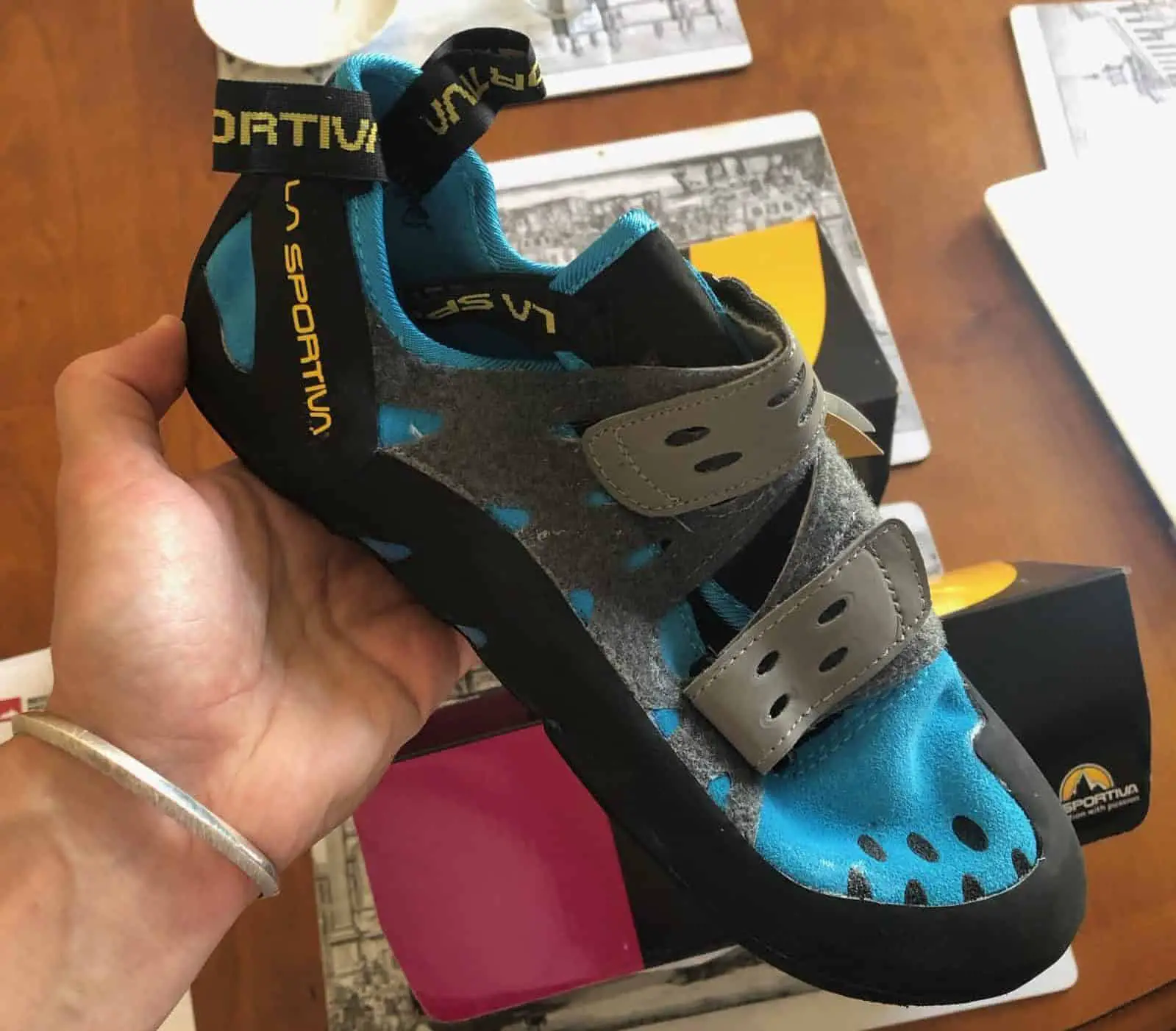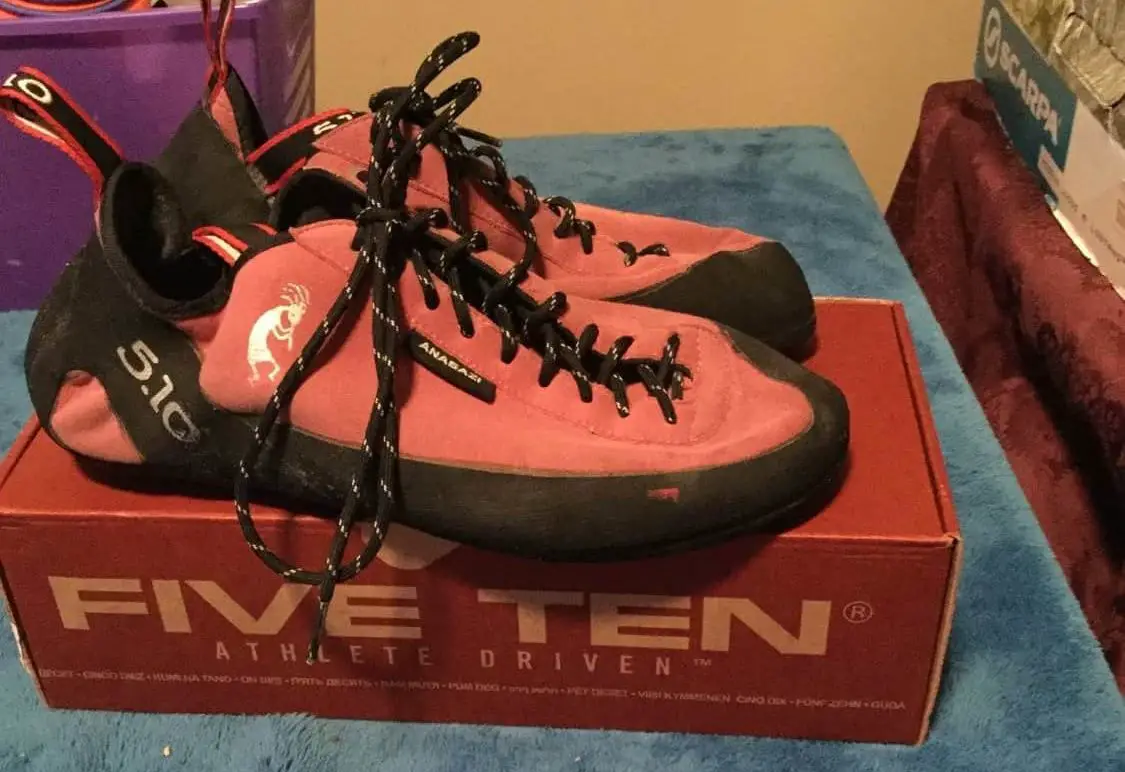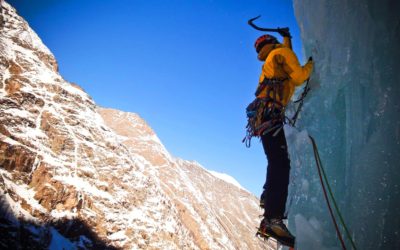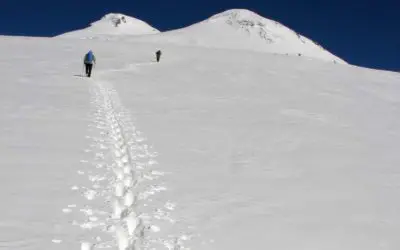
It has almost become a prestige among climbers to be able to boast about how small and tight climbing shoes can be used.
There is therefore a lot of talk about heavily curved toes, numb feet and other problems that can arise if you use too small climbing shoes.
On the other hand, there is very little talk about big climbing shoes and what the consequences are. Big climbing shoes, just like for small shoes, also has a very negative impact on the climber’s technique and power.
Since this is a topic people do not talk about so much, I think there are many climbers who, without knowing it uses, and has problems, with oversized climbing shoes.
That is why I have chosen to write this post where I first help you to recognize how an oversized climbing shoe feels.
You will also find further down in the text how to shrink climbing shoes that are, or have become, too big. Finally at the bottom I give some good advice on buying new climbing shoes.
Ways of knowing if your climbing shoes are too big
1. Air around the toes
You probably have an oversized, or wrong model of, climbing shoe if you feel that there is air above, below or in front of your toes. A climbing shoe with a perfect fit should feel like a second layer of skin that encloses the foot so that no air pockets are formed.
There are therefore several models to choose from with different shapes on the front of the shoe. Some have a rounded shape while others have a more square front, all for you as a climber to be able to buy a shoe that fits your feet.
2. Straight toes
To get good grip and strength, the toes must have a certain bend inside the shoes, otherwise you have to push away with the toes and toe tips as you climb.
As you probably understand, this gives you less power and you will quickly get tired of the muscles in the foot.
How bent should the toes be?
How much bending should the toes have? In my opinion, this is very individual. Many experienced and stubborn climbers often recommend extremely tight shoes that both hurt and bend their toes in an extreme way. Such tight shoes are not necessary in my opinion, climbing should be fun and not a form of torture you have to get used to.
Personally, I think climbing shoes should feel tight and stable without hurting your feet or numbing them.
Try to find out how much bending is right for you. You should feel that you have the power and control during the climb without any pressure feeling like a torment.
3. Slack around the heel
The fact that climbing shoes slip or sit loose around the heel is another clear sign that your shoe is too big.
As I mentioned before, a climbing shoe should be like a second layer of skin. A gaping shoe can be very distracting as you will probably experience a less safe and stable climb.
Because the shoe is not tight, you also lose power when you push away from the ground. This leads to unnecessary extra work for the calves, which in turn tire out faster and, in the worst case, suffer from cramps.
4. Large “cavities” inside climbing shoes
I know I will repeat myself now, but because it is so important I say it again – a climbing shoe should be like a second layer of skin around the foot. If you feel that the shoe has a lot of “cavities” around the toes, under the hollow foot and/or on top of the foot then this indicates an oversized climbing shoe.
Wrong model?
This phenomenon may also be due to the wrong shoe model for you. Maybe the size is right but you need to bet on a model that is narrower or that has a higher arch.
You can also consider investing in a laced model where you can adjust and tighten the lacing a little extra in the places where it tends to form cavities.
5. The climbing shoes have stretched themselves
Something that unfortunately happens to many climbing shoes, especially if they are made of leather, is that after a while they become stretched and thus become too big and/or lose shape.
I know many people choose leather shoes because they breathe better and become less sweaty than synthetic shoes.
They are also perceived as more comfortable because they shape according to the foot, but one should be aware that its formability can become a problem if they stretch too much.
2 ways of shrinking climbing shoes that are too big
As I just wrote, climbing shoes, and especially leather shoes, tend to stretch. Before you go out and buy a new pair, I have a few tips on how to make your climbing shoes smaller.
Unfortunately, all shoes cannot be shrunk
However, I would like to point out that the advice about washing your shoes doesn’t always work! Everything depends on the quality and characteristics of the shoe.
Some shoes shrink nicely so that the shoe sits tight on the foot while other models, unfortunately, quickly go back to the shape they had before shrinking them.
1. Launder the climbing shoes
If your climbing shoes are too big, you can try to shrink them by washing them in the washing machine.
Do not wash climbing shoes made of synthetic material!
Note that this washing tip only applies to leather shoes and not to synthetic shoes! If you have too large synthetic shoes, you can skip down to the section on using socks, otherwise there is unfortunately not much else to do but buy new shoes.
Wash at low temperature
In order not to damage the climbing shoes you should wash them at a low temperature and with no or very little detergent. Otherwise, there is a great risk that the leather and rubber in the shoes will be destroyed.
If you use climbing shoes with laces, remove the laces before loading the shoes in the washing machine.
Dry the climbing shoes properly
After washing the shoes, they must not be used until they are 100% dry.
If the leather is still damp or wet when using the shoes, they will stretch out again. (Using damp climbing shoes is, as you may know, a very effective way to stretch and shape new climbing shoes).
Dry the climbing shoes in a natural way
The best way to dry the climbing shoes is to just leave them at room temperature or alternatively set them in the sun.
The shoes should definitely not be dried in the oven, dryer or drying cabinet as this will destroy the leather and in the worst case even melt the rubber of the shoe.
Soak up the moisture in the shoes with newspaper
The climbing shoes dry faster if you put newspaper in the shoes.
The paper will absorb moisture which not only speeds up the drying process but also helps to shrink the shoes a little extra. The newspaper should be replaced every hour so that it constantly absorbs moisture.
2. Use socks
I know that many, like myself, prefer to climb barefoot. But by using a pair of thin socks you can get better stability and comfort in climbing shoes that are too big. Of course, you should choose thin socks without seams.
If you do not want this as a permanent solution, it may be good enough to apply until you have purchased a pair of new climbing shoes.

Here’s how to find the right size when buying new climbing shoes:
Buy climbing shoes towards the end of the day
To find a climbing shoe with a perfect fit you should always try out new shoes towards the end of the day when your feet are slightly swollen. This is because your feet will swell as you climb due to increased circulation.
If you do not have the opportunity to visit the store late in the day, you can take a quick walk before you start trying shoes so that you get more blood to your feet.
Climbing shoes should feel like a second layer of skin
As I have said so many times before – a climbing shoe should not feel like a shoe but as a second layer of skin on the feet. It should almost feel like you are climbing barefoot instead of wearing shoes.
Find the ‘’sweet spot’’
Sweet spot is when the climbing shoe feels tight and stable but without being so tight that it becomes uncomfortable.
Since all climbing shoes stretch, especially leather shoes, the shoe should feel a little too uncomfortable when you buy it. Hopefully, after a period of use, it will have stretched and got a perfect fit.
If after a few months you still feel that the shoes are a little too tight, you can always wet them and walk around, or climb with them so that they stretch a little extra.
Talk to other climbers about the models they use
Since a shoe stretches between ½-1 size after one or several months of use, it is incredibly difficult to know how much “too small” shoe you should buy.
Therefore, I recommend you to talk to your climbing buddies about what shoe model they use and how much it has stretched.
You can also go to different climbing forums online if no one is using the particular shoe model you are interested in.
Use the right shoe model for the right type of climbing and footing
What kind of climbing?
As you have probably noticed, there is a whole plethora of climbing shoes which can be very confusing. But it’s not really as hard as it may seem at first. Initially, different shoe models are adapted for different types of climbing, so choose the shoe that suits your climbing style.
What does your foot look like?
You need to learn what kind of foot you have. Are your toes about the same length or do they get smaller and smaller the closer you get to the little toe? Do you have a high or low foot arch? Is your heel slim or wide? Are you wide or narrow above your feet just above your toes?
When you have the answer to these questions, it will actually be quite easy to find the right model.
Slide on, Velcro or lacing?
When choosing between slide on models, or climbing shoes with Velcro or drawstring, I think it is a matter of taste.
The choice really depends a lot on how good the shoe fits on your foot.
Climbing shoes with laces or Velcro are easier to remove when your feet have swelled up after a long day of climbing. These models can also be easier to adjust the fit on the top of the foot.
Many people prefer slide on models because they feel they are tighter around the foot and that they do not have problems with lacing that loosens and Velcro that releases.
Try out your new climbing shoes in store
Since the sizes of climbing shoes vary greatly between different brands, and sometimes even between different models within the same brand, I find it more or less impossible to buy climbing shoes online.
sThe big differences are because many climbing shoes, especially more expensive models of leather, are manufactured by hand. That’s why I almost always buy my shoes in stores where I can both get help from knowledgeable staff and try the different models.
Buying climbing shoes online
If you prefer to shop for climbing shoes online, I have a tip that I use the few times I shop shoes over the internet. Buy two or three pairs of the same model but with different sizes. I know it will require some cash flow before you can return them, but then you can try out the size that is right for you in that particular model.
Review the return policy when buying online
Before clicking home new climbing shoes from the internet, I recommend that you review the company’s return policy. For example, most people never approve a return if the shoes have been used, even if you have only tested them on a climbing wall indoors.
To be able to feel what the shoes are like to climb with, I usually do some “toe lifting” on a staircase to see how it feels to push away with them.
Conclusion
I hope that with this post you have learned to recognize an oversized climbing shoe. It will also feel extra good if you have also brought with you valuable knowledge to help you in the search for the perfect climbing shoes.
Written by Felix

About me
Hi! I’m Felix. When I’m not spending time out in the mountains, I like to write about my hobbies. That is how Mountain Homies was created. On this site, I try to gather all the juicy information about Mountaineering that I have learned since I started. Happy adventures!
Related Articles
Rock Climbing vs Ice Climbing: Everything You Need To Know
In summary, In Ice climbing you need more equipment and falling is more dangerous than in rock climbing. Routes on ice and rock have…
World’s 11 Highest Unclimbed Mountains
Unclimbed peaks are often referred to as Virgin peaks. Many of these peaks are considered to be tougher and more difficult than Everest. Furthermore, the mountains…
9 Pros and Cons of Climbing in Ski boots
You’re heading to some awesome back country ice climbing crags for the day. The prize if awesome: pristine ice climbing routes that…
Stay Up to Date With The Latest News & Updates
Join Our Newsletter
The owner of this site is a participant in the Amazon Services LLC Associates Program, an affiliate advertising program designed to provide a means for sites to earn advertising fees by advertising and linking to amazon.com.




